"New Deal" of President FD Roosevelt and its results.
"New Deal" of President FD Roosevelt and its results.


#1 слайд
"New Deal" of President FD
Roosevelt and its results.
Тексерген: Шекербеков Қ.
ОРЫНДАҒАН: Қартбаева Ж.Қ
Performed : Zakirova A. B.
Esil, 2023
1 слайд
"New Deal" of President FD Roosevelt and its results. Тексерген: Шекербеков Қ. ОРЫНДАҒАН: Қартбаева Ж.Қ Performed : Zakirova A. B. Esil, 2023
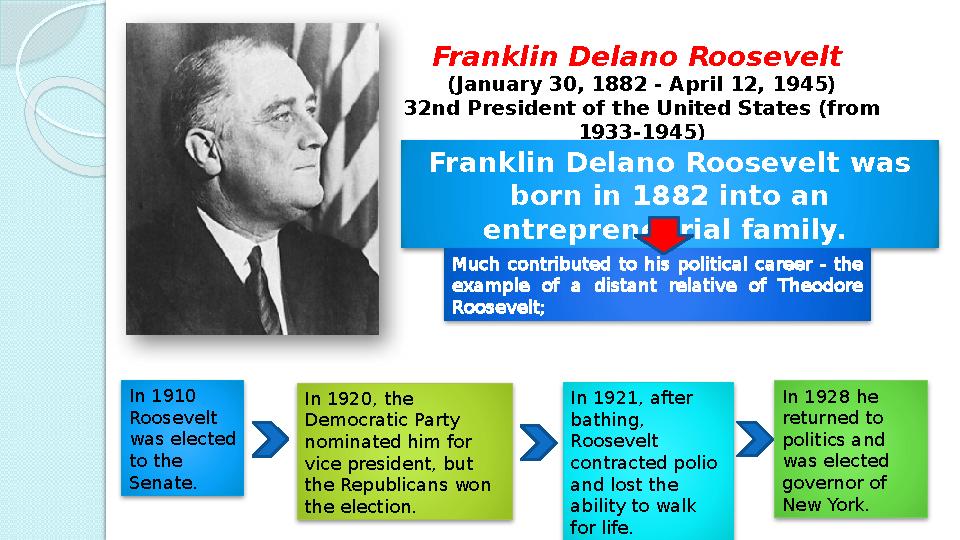
#2 слайд
Franklin Delano Roosevelt
(January 30, 1882 - April 12, 1945)
32nd President of the United States (from
1933-1945)
Franklin Delano Roosevelt was
born in 1882 into an
entrepreneurial family.
Much contributed to his political career - the
example of a distant relative of Theodore
Roosevelt;
In 1910
Roosevelt
was elected
to the
Senate . In 1921, after
bathing,
Roosevelt
contracted polio
and lost the
ability to walk
for life. In 1928 he
returned to
politics and
was elected
governor of
New York. In 1920, the
Democratic Party
nominated him for
vice president, but
the Republicans won
the election.
2 слайд
Franklin Delano Roosevelt (January 30, 1882 - April 12, 1945) 32nd President of the United States (from 1933-1945) Franklin Delano Roosevelt was born in 1882 into an entrepreneurial family. Much contributed to his political career - the example of a distant relative of Theodore Roosevelt; In 1910 Roosevelt was elected to the Senate . In 1921, after bathing, Roosevelt contracted polio and lost the ability to walk for life. In 1928 he returned to politics and was elected governor of New York. In 1920, the Democratic Party nominated him for vice president, but the Republicans won the election.
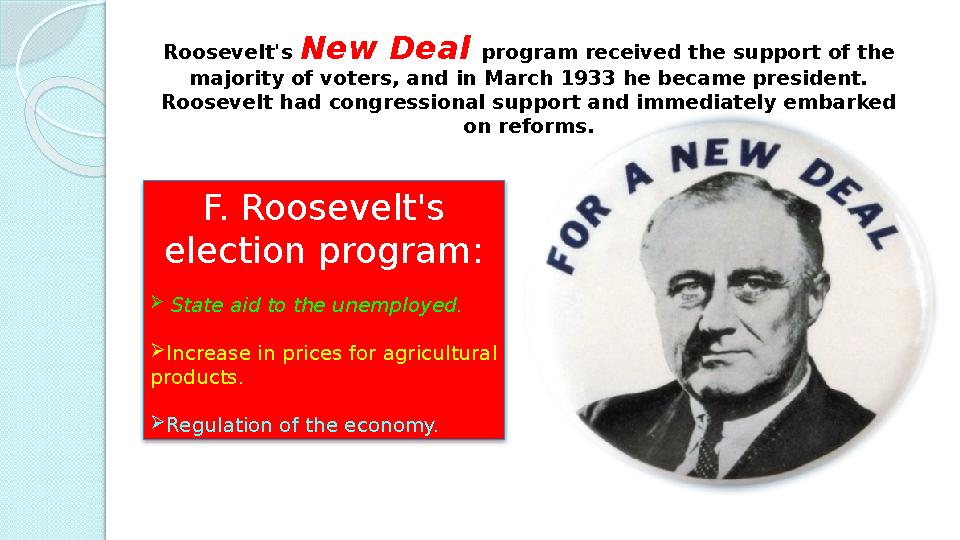
#3 слайд
Roosevelt's New Deal program received the support of the
majority of voters, and in March 1933 he became president.
Roosevelt had congressional support and immediately embarked
on reforms.
F. Roosevelt's
election program :
State aid to the unemployed.
Increase in prices for agricultural
products.
Regulation of the economy.
3 слайд
Roosevelt's New Deal program received the support of the majority of voters, and in March 1933 he became president. Roosevelt had congressional support and immediately embarked on reforms. F. Roosevelt's election program : State aid to the unemployed. Increase in prices for agricultural products. Regulation of the economy.
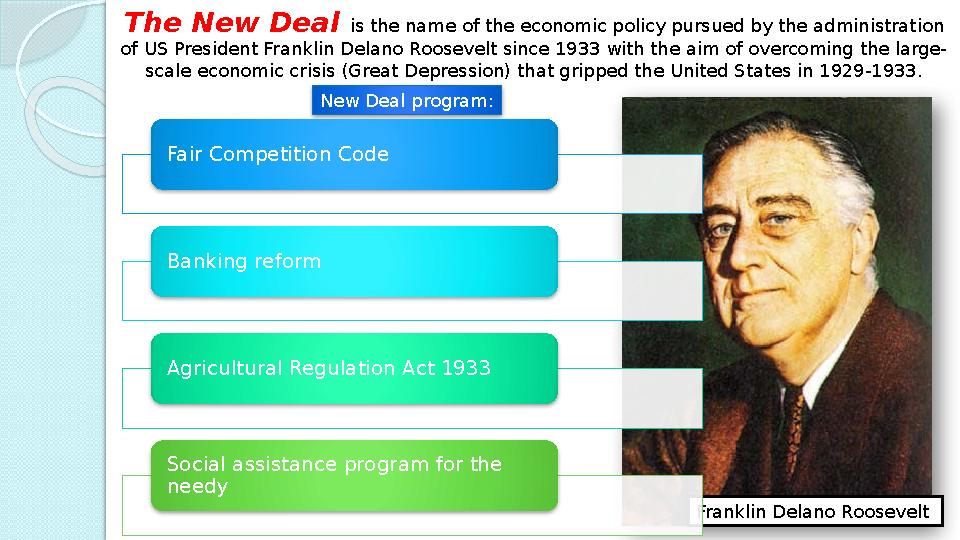
#4 слайд
The New Deal is the name of the economic policy pursued by the administration
of US President Franklin Delano Roosevelt since 1933 with the aim of overcoming the large-
scale economic crisis (Great Depression) that gripped the United States in 1929-1933.
Franklin Delano Roosevelt New Deal program:
Fair Competition Code
Banking reform
Agricultural Regulation Act 1933
Social assistance program for the
needy
4 слайд
The New Deal is the name of the economic policy pursued by the administration of US President Franklin Delano Roosevelt since 1933 with the aim of overcoming the large- scale economic crisis (Great Depression) that gripped the United States in 1929-1933. Franklin Delano Roosevelt New Deal program: Fair Competition Code Banking reform Agricultural Regulation Act 1933 Social assistance program for the needy

#5 слайд
To stabilize the situation in
the economy, a number of
important laws were
adopted:The Roosevelt government
immediately took extraordinary
measures - on March 9, a special
session of Congress began its work,
which adopted a number of
important laws that seriously
influenced the US economy and laid
the foundation for the New Deal.Taking office on
March 4, 1933,
Franklin Roosevelt in
his speech promised
to apply the most
energetic measures
to combat the crisis. The New Deal
This period was called the "first 100 days". The most
important
task was to
rescue and
stabilize the
US financial
system. The policy of the new
course was based on
measures to strengthen
state regulation of the
economy, budget deficit
financing, and major
institutional
transformations.
1. In the field of
banking.
2. In industry.
3. In the social
sphere.
4. In the field of
agriculture.The New Deal project is the construction of a power
plant on the Tennessee River. 1930s
5 слайд
To stabilize the situation in the economy, a number of important laws were adopted:The Roosevelt government immediately took extraordinary measures - on March 9, a special session of Congress began its work, which adopted a number of important laws that seriously influenced the US economy and laid the foundation for the New Deal.Taking office on March 4, 1933, Franklin Roosevelt in his speech promised to apply the most energetic measures to combat the crisis. The New Deal This period was called the "first 100 days". The most important task was to rescue and stabilize the US financial system. The policy of the new course was based on measures to strengthen state regulation of the economy, budget deficit financing, and major institutional transformations. 1. In the field of banking. 2. In industry. 3. In the social sphere. 4. In the field of agriculture.The New Deal project is the construction of a power plant on the Tennessee River. 1930s
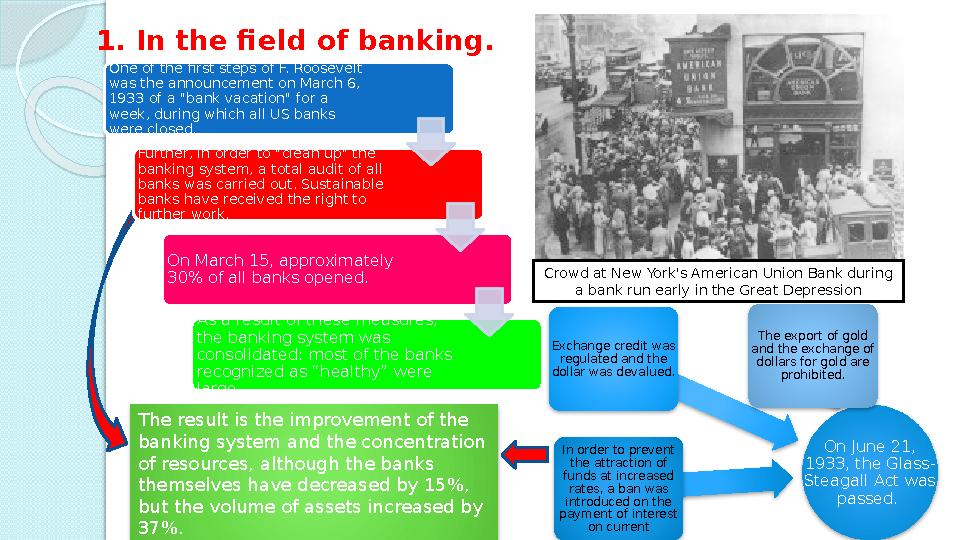
#6 слайд
1. In the field of banking.
Crowd at New York's American Union Bank during
a bank run early in the Great Depression
On June 21,
1933, the Glass-
Steagall Act was
passed. In order to prevent
the attraction of
funds at increased
rates, a ban was
introduced on the
payment of interest
on currentExchange credit was
regulated and the
dollar was devalued. The export of gold
and the exchange of
dollars for gold are
prohibited.
The result is the improvement of the
banking system and the concentration
of resources, although the banks
themselves have decreased by 15%,
but the volume of assets increased by
37%.One of the first steps of F. Roosevelt
was the announcement on March 6,
1933 of a "bank vacation" for a
week, during which all US banks
were closed.
Further, in order to "clean up" the
banking system, a total audit of all
banks was carried out. Sustainable
banks have received the right to
further work.
On March 15, approximately
30% of all banks opened.
As a result of these measures,
the banking system was
consolidated: most of the banks
recognized as “healthy” were
large.
6 слайд
1. In the field of banking. Crowd at New York's American Union Bank during a bank run early in the Great Depression On June 21, 1933, the Glass- Steagall Act was passed. In order to prevent the attraction of funds at increased rates, a ban was introduced on the payment of interest on currentExchange credit was regulated and the dollar was devalued. The export of gold and the exchange of dollars for gold are prohibited. The result is the improvement of the banking system and the concentration of resources, although the banks themselves have decreased by 15%, but the volume of assets increased by 37%.One of the first steps of F. Roosevelt was the announcement on March 6, 1933 of a "bank vacation" for a week, during which all US banks were closed. Further, in order to "clean up" the banking system, a total audit of all banks was carried out. Sustainable banks have received the right to further work. On March 15, approximately 30% of all banks opened. As a result of these measures, the banking system was consolidated: most of the banks recognized as “healthy” were large.
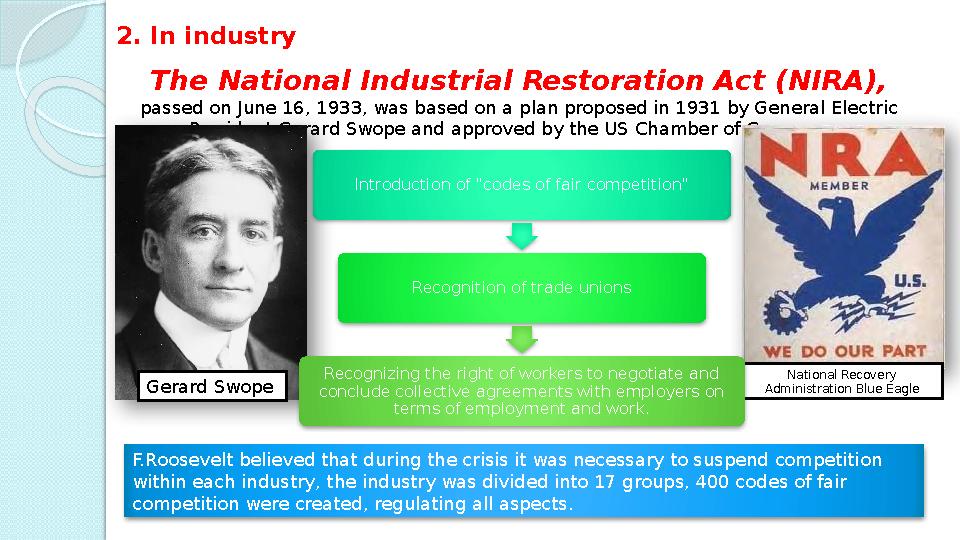
#7 слайд
The National Industrial Restoration Act (NIRA),
passed on June 16, 1933, was based on a plan proposed in 1931 by General Electric
President Gerard Swope and approved by the US Chamber of Commerce.2. In industry
National Recovery
Administration Blue Eagle
Gerard Swope Introduction of "codes of fair competition"
Recognition of trade unions
Recognizing the right of workers to negotiate and
conclude collective agreements with employers on
terms of employment and work.
F.Roosevelt believed that during the crisis it was necessary to suspend competition
within each industry, the industry was divided into 17 groups, 400 codes of fair
competition were created, regulating all aspects.
7 слайд
The National Industrial Restoration Act (NIRA), passed on June 16, 1933, was based on a plan proposed in 1931 by General Electric President Gerard Swope and approved by the US Chamber of Commerce.2. In industry National Recovery Administration Blue Eagle Gerard Swope Introduction of "codes of fair competition" Recognition of trade unions Recognizing the right of workers to negotiate and conclude collective agreements with employers on terms of employment and work. F.Roosevelt believed that during the crisis it was necessary to suspend competition within each industry, the industry was divided into 17 groups, 400 codes of fair competition were created, regulating all aspects.

#8 слайд
3. In the social sphere
Unemployment rate in the United States in 1910-1960 On May 12, 1933,
about $ 0.5 billion
was allocated to help
the unemployed.
The
governmen
t paid great
attention to
measures
to increase
youth
employmen
t. In the spring of
1933, the first
camps for
unemployed
youth were
created, which
took during 1933-
1939 about 2
million people
under the age of
25. In 1933, the
government adopted a
program for the
construction of state-
owned hydroelectric
power plants to supply
nitrogen fertilizer
production in the
Tennessee basin housing
construction and
mortgage lending
in 1933, the first company to issue bonds
for mortgage financing was created - the
Home Owners Loan Corporation.
photos of Americans without home and work
8 слайд
3. In the social sphere Unemployment rate in the United States in 1910-1960 On May 12, 1933, about $ 0.5 billion was allocated to help the unemployed. The governmen t paid great attention to measures to increase youth employmen t. In the spring of 1933, the first camps for unemployed youth were created, which took during 1933- 1939 about 2 million people under the age of 25. In 1933, the government adopted a program for the construction of state- owned hydroelectric power plants to supply nitrogen fertilizer production in the Tennessee basin housing construction and mortgage lending in 1933, the first company to issue bonds for mortgage financing was created - the Home Owners Loan Corporation. photos of Americans without home and work

#9 слайд
The most important achievement of the New Deal was the
creation of a social insurance system .
In August 1935, a law was passed
providing for insurance for old age and
unemployment.
The next stage in the development of
social rights was the adoption in June
1938 of the Fair Working Conditions
Law (FSLA),
which provided for a mandatory
minimum wage of 25 cents per hour,
the introduction of a one and a half
tariff when the working week was
exceeded , child labor was limited.
9 слайд
The most important achievement of the New Deal was the creation of a social insurance system . In August 1935, a law was passed providing for insurance for old age and unemployment. The next stage in the development of social rights was the adoption in June 1938 of the Fair Working Conditions Law (FSLA), which provided for a mandatory minimum wage of 25 cents per hour, the introduction of a one and a half tariff when the working week was exceeded , child labor was limited.
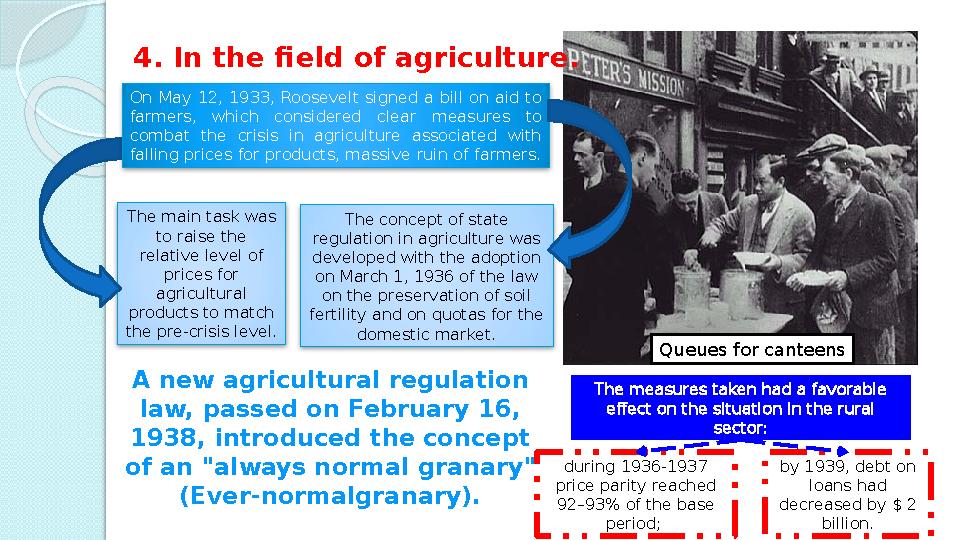
#10 слайд
Queues for canteens4. In the field of agriculture.
On May 12, 1933, Roosevelt signed a bill on aid to
farmers, which considered clear measures to
combat the crisis in agriculture associated with
falling prices for products, massive ruin of farmers.
The main task was
to raise the
relative level of
prices for
agricultural
products to match
the pre-crisis level. The concept of state
regulation in agriculture was
developed with the adoption
on March 1, 1936 of the law
on the preservation of soil
fertility and on quotas for the
domestic market.
A new agricultural regulation
law, passed on February 16,
1938, introduced the concept
of an "always normal granary"
(Ever-normalgranary). The measures taken had a favorable
effect on the situation in the rural
sector:
during 1936-1937
price parity reached
92–93% of the base
period; by 1939, debt on
loans had
decreased by $ 2
billion.
10 слайд
Queues for canteens4. In the field of agriculture. On May 12, 1933, Roosevelt signed a bill on aid to farmers, which considered clear measures to combat the crisis in agriculture associated with falling prices for products, massive ruin of farmers. The main task was to raise the relative level of prices for agricultural products to match the pre-crisis level. The concept of state regulation in agriculture was developed with the adoption on March 1, 1936 of the law on the preservation of soil fertility and on quotas for the domestic market. A new agricultural regulation law, passed on February 16, 1938, introduced the concept of an "always normal granary" (Ever-normalgranary). The measures taken had a favorable effect on the situation in the rural sector: during 1936-1937 price parity reached 92–93% of the base period; by 1939, debt on loans had decreased by $ 2 billion.
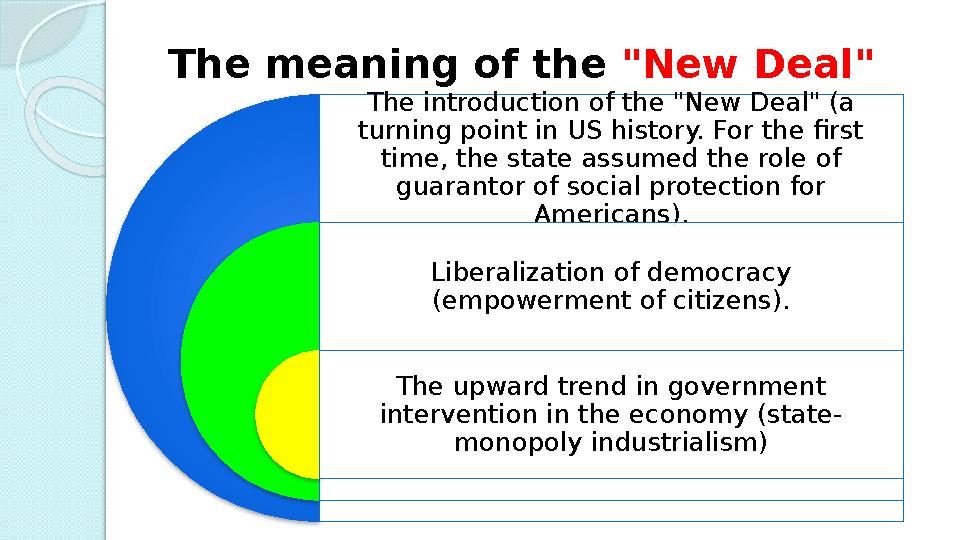
#11 слайд
The meaning of the "New Deal"
The introduction of the "New Deal" (a
turning point in US history. For the first
time, the state assumed the role of
guarantor of social protection for
Americans).
Liberalization of democracy
(empowerment of citizens).
The upward trend in government
intervention in the economy (state-
monopoly industrialism)
11 слайд
The meaning of the "New Deal" The introduction of the "New Deal" (a turning point in US history. For the first time, the state assumed the role of guarantor of social protection for Americans). Liberalization of democracy (empowerment of citizens). The upward trend in government intervention in the economy (state- monopoly industrialism)

#12 слайд
A poster publicizing Social
Security benefitsReform results:
1 •
Banking system stabilization.
2 •
The situation of farmers has improved.
3 •
In the Tennessee River Valley, 25 power
plants were built, the river became
navigable, young forests rose, soil erosion
was stopped, and people began to live
better.
4 •
Improved labor legislation (Wagner's
law).
5 •
The implementation of the NIRA law
strengthened the position of large
monopolies, since they determined the
conditions for production and marketing.
12 слайд
A poster publicizing Social Security benefitsReform results: 1 • Banking system stabilization. 2 • The situation of farmers has improved. 3 • In the Tennessee River Valley, 25 power plants were built, the river became navigable, young forests rose, soil erosion was stopped, and people began to live better. 4 • Improved labor legislation (Wagner's law). 5 • The implementation of the NIRA law strengthened the position of large monopolies, since they determined the conditions for production and marketing.

#13 слайд
Providing social
peace.
increasing
income levels.
concentration of
production.
expansion of
trade and
economic
relations with
other countries. Federal Emergency Relief Administration (FERA)
camp for unemployed women in Maine, 1934Results of the "New Deal"
13 слайд
Providing social peace. increasing income levels. concentration of production. expansion of trade and economic relations with other countries. Federal Emergency Relief Administration (FERA) camp for unemployed women in Maine, 1934Results of the "New Deal"
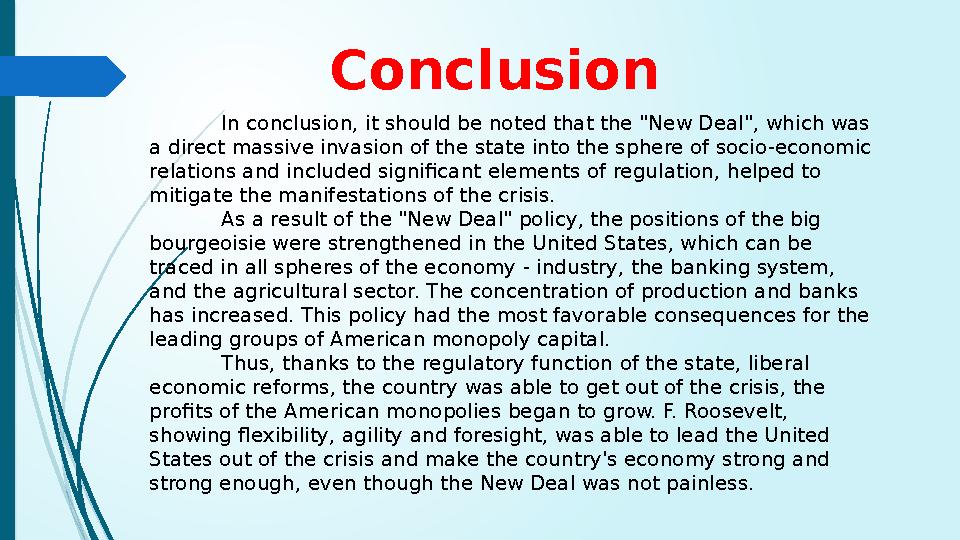
#14 слайд
In conclusion, it should be noted that the "New Deal", which was
a direct massive invasion of the state into the sphere of socio-economic
relations and included significant elements of regulation, helped to
mitigate the manifestations of the crisis.
As a result of the "New Deal" policy, the positions of the big
bourgeoisie were strengthened in the United States, which can be
traced in all spheres of the economy - industry, the banking system,
and the agricultural sector. The concentration of production and banks
has increased. This policy had the most favorable consequences for the
leading groups of American monopoly capital.
Thus, thanks to the regulatory function of the state, liberal
economic reforms, the country was able to get out of the crisis, the
profits of the American monopolies began to grow. F. Roosevelt,
showing flexibility, agility and foresight, was able to lead the United
States out of the crisis and make the country's economy strong and
strong enough, even though the New Deal was not painless. Conclusion
14 слайд
In conclusion, it should be noted that the "New Deal", which was a direct massive invasion of the state into the sphere of socio-economic relations and included significant elements of regulation, helped to mitigate the manifestations of the crisis. As a result of the "New Deal" policy, the positions of the big bourgeoisie were strengthened in the United States, which can be traced in all spheres of the economy - industry, the banking system, and the agricultural sector. The concentration of production and banks has increased. This policy had the most favorable consequences for the leading groups of American monopoly capital. Thus, thanks to the regulatory function of the state, liberal economic reforms, the country was able to get out of the crisis, the profits of the American monopolies began to grow. F. Roosevelt, showing flexibility, agility and foresight, was able to lead the United States out of the crisis and make the country's economy strong and strong enough, even though the New Deal was not painless. Conclusion

#15 слайд
Thank you for
your attention !
15 слайд
Thank you for your attention !

шағым қалдыра аласыз
















